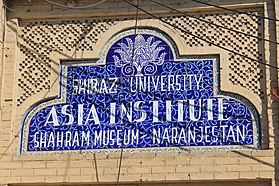Asia Institute
 | |
| Formation | 1928 |
|---|---|
| Founder | Arthur Upham Pope, Phyllis Ackerman |
| Dissolved | 1979 |
| Headquarters | Shiraz, Iran |
Formerly called | American Institute for Persian Art and Archaeology |
The Asia Institute (1928–1979) was an American organization in support of research and interest in Persian art and archaeology; and starting in 1964 it was funded by the Pahlavi-era Iran. Two remnants from the Asia Institute are the Bulletin of the Asia Institute, published in the United States, and the Qavam House museum (or Narenjestan) at Shiraz University, Iran.[1][2]
History
The Asia Foundation was founded in 1928 in
The Asia Institute was founded by
Due to close contacts with the royal family of Iran, Pope and his wife moved to Shiraz in 1966, where the Asia Institute was re-established as a part of Pahlavi University (now Shiraz University) and housed in the late-nineteenth-century Qajari mansion called the Qavam House (or Narenjestan).[3] The institute organized the 5th International Congress of Iranian Art and Archaeology, which took place in Tehran in 1968.
The Asia Institute in Shiraz was closed after the
- Asia Institute
-
Garden and building of Qavam House (Narenjestan-e Ghavam)
-
Sign
References
- ^ a b c d e Frye, Richard N. (July 20, 2003). "Asia Institute". Encyclopædia Iranica. Archived from the original on 2011-04-29.
- ^ Narenjestan Mansion website "Naranjestan". Archived from the original on 2014-05-28. Retrieved 2012-07-29.
- ^ a b Montgomery, Cornelia (July 20, 2002). "Ackerman, Phyllis". Encyclopaedia Iranica. Archived from the original on 2011-04-29.
- ISSN 0362-4331. Retrieved 2021-09-10.
- ISSN 0075-8744.


